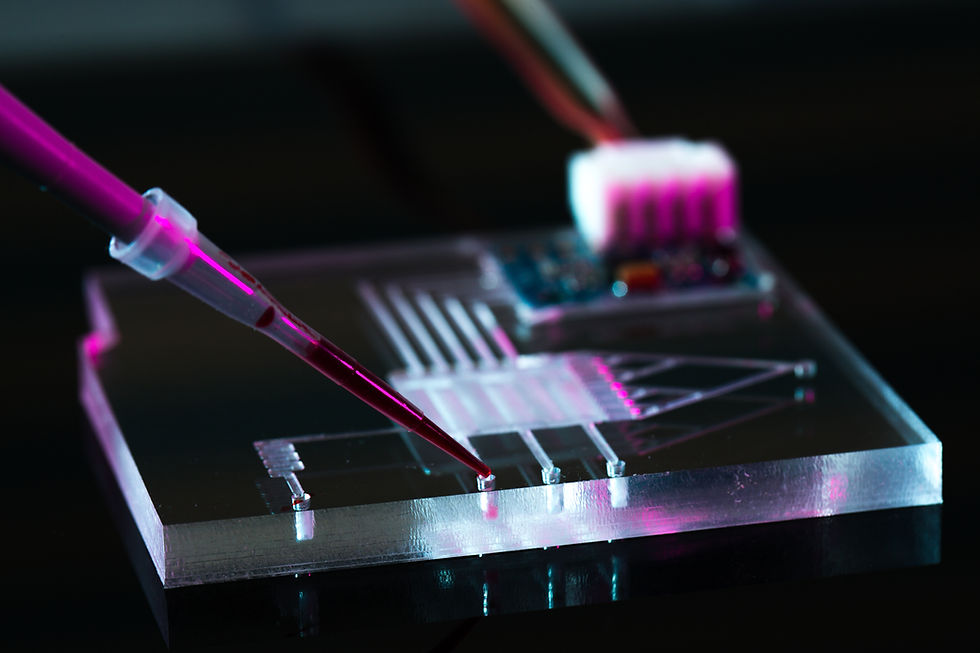From Brain to Bench to Bedside and Beyond: How a DC Neuroscientist is Changing Brain Disease Research
- Aidan Schurr
- Feb 15
- 7 min read
Updated: Jul 24
The position of working in the Capital of the United States offers unparalleled opportunities for those who want to effect change in medicine. Dr. Brent Harris is a physician-scientist whose work in neuropathology, brain sampling, and ALS has helped millions of Americans. His reach extends beyond traditional clinical care; his development of Brain Banks and promotion of legislation for ALS research has allowed Harris to leave a lasting mark on neurodegenerative disease research. It is pivotal to understand how Harris’ proximity to the nation’s capital has facilitated his ultimate goal as a Physician: to improve the lives of patients.
Who is Dr. Brent Harris?
Dr. Brent Harris is a Professor of Neuropathology at Georgetown University, and an Adjunct Associate Professor at both George Washington University and Howard University, whose current work focuses on neurodegeneration and the underlying influence of glial-neuronal relationships in the development of neurological diseases. From an early age, Harris loved both science and medicine and decided to pursue both, he said. As a physician-scientist, Dr. Harris’s work ranges from brain tissue lab research to extensive patient care. After completing his MD/PhD at Georgetown University, Harris conducted his Residency Pathology at Stanford University Medical School. Harris returned to his alma mater in 2010, this time as a Georgetown Medical School professor. He has since established the Georgetown Brain Bank and POND Bank, in addition to assuming the Office of the Chief Medical Examiner for DC. Here he has been utilizing his proximity to the capital to initiate and lead many programs to advance the treatment and research for neuroinflammatory diseases including working with National organizations such as NIH.
Why His Work Matters
Above all, Dr. Harris epitomizes every physician's vocational heart and every scientist's curious mind, combining both professions to help investigate the most difficult questions about brain disease. Learning about how Dr. Harris has maintained a profound impact in both clinical and translational research settings can inspire future students to pursue careers that emphasize the importance of making an impact that will be felt across the intricate fields of biomedical sciences. Lastly, Dr. Harris’ commitment to service in battling brain disease nationwide, demonstrates the significance of working in Medicine in the capital of the United States.
The MD/PhD Journey
Before we can begin to understand Dr. Harris, we must first understand how he arrived at his current position. What is an MD/PhD? Why an MD/PhD? And what is a Neuropathologist? And funnily enough, Dr. Harris was once sitting in your exact seats asking the exact same questions.
Like many, Dr. Harris was a fan of science and medicine but was confused as to where these loves would lead him. In undergraduate, he pursued a Liberal Arts degree and balanced this with courses in the natural sciences. Before long, he found himself in a Summer program at the National Institutes of Health and decided he was going to pursue a career in the biomedical sciences. Once he completed a Master's in Biochemistry, he decided he finally was ready to apply to Medical School and devote his career in Medicine.
However, he did not want to leave science behind. Thus, he applied to pursue an MD/PhD. The MD/PhD is a combined program offered at many Medical Schools in order to train a unique group of Physician-Scientists, Doctors who can interface between the worlds of clinical and basic research, offering a wide expertise across a range of disciplines. Dr. Harris applied to Georgetown Medical School and pursued an MD/PhD in Neuroscience, citing the Brain as the “Final Frontier” in Medicine.
Faced with the decision of residency, Dr. Harris could choose Neurology, the study of diagnosing and managing disorders of the nervous system; Psychiatry, focusing on the diagnosis and treatment of mental health conditions; Neurosurgery, involving surgical interventions to treat diseases of the brain and spinal cord; or Neuropathology, the microscopic study of nervous system tissues to understand disease at the cellular level. Ultimately he found Neuropathology to be the most complimentary for understanding the core mechanisms of the brain’s functions as well as an avenue for critical support in all aspects of medicine.
“You kind of break down neuropathology into the clinical aspects, the teaching aspects and the research aspects,” Harris said. “I chose neuropathology because I enjoy doing all three of those things.”
After making this leap into the unknown, Dr. Harris continued his career with stints in Residency at Stanford Medical Center and working at Dartmouth University. Only after this period, did Dr Harris finally return to DC, once again working in his Alma Mater of Georgetown University.
“I choose the last unknown frontier in medicine, the neurosciences when deciding where I wanted to spend the next 40-50 years”
Building Bridges with Brain Banks
After arriving in Washington DC, Dr. Harris began to understand the real nature of his responsibility as a physician-scientist. With training in both basic research and clinical care, Dr. Harris serves as a unique thoroughfare between the worlds of science and medicine. Naturally, Dr. Harris began to become involved in a myriad of programs and initiatives that he could lend his specific blend of expertise.
Enter Brain Banks, a physical database to host specimens of brain tissue used for basic research. He describes them as “banks” in the truest sense, where clinical data, tissue, and fluids are carefully collected, classified, and stored for future research. This process allows researchers to study diseases like ALS at an unprecedented depth, leveraging tools like genomics, proteomics, and transcriptomics —“Any omics you can think of,” as Dr. Harris describes.
These advanced approaches, combined with the use of patient tissue, are unlocking critical insights into disease mechanisms, particularly neuroinflammation and the interplay between glial and neuronal cells that drive ALS progression. Oftentimes researchers can discern the presence of hereditary diseases through the proper use of brain banks when connected to deceased family members. Here Dr. Harris can merge his two expertise, as he can clinically consent and work with the patients and then utilize his background in pathology to collect and understand tissue samples.
However, the ability to host and store these tissues is quite difficult, considering the IRB approval necessary to collect the tissues and the economic upkeep of the physical space of these sensitive gigabytes of information. Here, Dr. Harris sets himself apart due to his unwavering commitment to the public good and the use of his resources. Through Georgetown’s prominence in the U.S. capital, Dr. Harris has been able to continually fight for grants to upkeep the Georgetown Brain Bank and simultaneously start new initiatives across the United States. With developments in Machine Learning and improving the speed of analysis and the accuracy of reports, each brain tissue is becoming increasingly more valuable in the information they can provide. Therefore, Dr. Harris and his team’s work is not only actively supporting patients directly, but indirectly leading to discoveries in labs across the nation. Dr Harris recognizes that a paper can only do so much and through providing tissue samples to other researchers, he exponentially advances the research for neurodegenerative diseases one brain at a time.
Targeting ALS: From Lab Work to Legislative Action
Dr. Harris’s work extends beyond the lab and brain bank, reflecting his unwavering commitment to understanding and combating devastating neurological diseases. Currently Dr. Harris finds his most far-reaching work through the legislative initiatives started by governmental organizations. As part of the ALL ALS initiative, Dr. Harris played a pivotal role in passing legislation to bolster funding and accessibility for brain banks and research sites across the United States. This initiative represents a monumental leap in uniting clinical and translational research, enabling 35 sites nationwide to collect brain tissue, blood, and cerebrospinal fluid. These resources are critical for identifying early biomarkers and therapeutic targets, with the ultimate goal of transforming ALS from a fatal disease into a treatable condition. The ALL ALS initiative exemplifies the power of "team science," where neurologists, molecular biologists, and bioengineers collaborate to address one of neuroscience’s most pressing challenges. Dr. Harris underscores that this collaborative approach allows for the integration of diverse expertise, which is essential to tackling the complex mechanisms underlying ALS.
Dr. Harris’s dedication to advancing ALS research is also evident in his leadership of the Target ALS program. This initiative was created to address a significant gap in ALS research: the availability of high-quality tissues and biofluids for scientific study. As a neuropathologist and Director of the Georgetown Brain Bank, Dr. Harris has championed the importance of brain banks as foundational tools in research. For Dr. Harris, neuropathology is more than a field—it is a vocation that bridges science and medicine. His work highlights the critical role of neuropathologists as collaborators and stewards of human tissue, advancing both research and patient care. As he explains, neuropathologists are uniquely positioned to teach others about the human aspect of diseases and their pathological underpinnings. By enabling researchers to access high-quality, anonymized samples, Dr. Harris’s brain bank supports scientific discovery and honors the profound generosity of donors and their families. This ethos extends to his research, where he uses advanced molecular biology and cutting-edge tools like machine learning to explore how glial cells contribute to disease. Dr. Harris’s work is a testament to the transformative potential of neuropathology, uniting clinical insight and scientific inquiry to combat ALS and other neurological diseases.
Key Highlights and Takeaways
Dr. Harris’ path and experience represent a crucial identity that all aspiring scientists should have - your work is a vocation. The centrality of this premise is represented through the extremely diverse body of work that Dr. Harris has accumulated throughout his long career. Through legislative initiatives, symposiums and basic research the scope of his efforts to help patients through their neurodegenerative diseases is immense.
In addition, being a leading physician and investigator in Washington, D.C. has allowed Dr. Harris to promote his research on a national and international level. As Harris said, “There is no place I would rather be” when I asked why he continued to pursue his research and work in the Capital of the United States. Dr Harris reminds all of us that our unique interests can be melded together and in fact beneficial to our careers. Moreover, sometimes the most valuable thing we can do is put ourselves in the right place to let our work impact the most people.







Comments